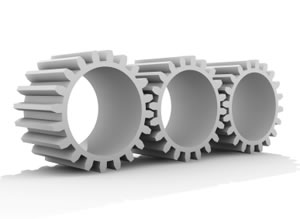When rapid prototyping of multiple-piece assemblies becomes a necessity, we utilize the unique processing services provided by outside service bureaus. There are two options available: Stereo-lithography (SLA) and selective laser sintering (SLS).
Stereo-lithography is a 3-D layering manufacturing process that applies ultra-violet lasers to cure liquid photo-polymer resins to produce solid, plastic, 3-D objects that simulate properties of polyethylene, polypropylene and poly carbonate materials.
 Selective laser sintering is another type of prototype process. With SLA, the model is made from heated powder with a laser that creates the 3-D layers by fusing the particles together. These powdered materials can be nylon, glass-filled nylon, polystyrene or alumide resins.
Selective laser sintering is another type of prototype process. With SLA, the model is made from heated powder with a laser that creates the 3-D layers by fusing the particles together. These powdered materials can be nylon, glass-filled nylon, polystyrene or alumide resins.
SLA and SLS both produce very good prototypes, but their individual application depends on the desired requirements for the final model. If the prototype requires durability and good structural properties for functionality testing and assembly trials, then SLS is the recommended process. If the desire is for a model with excellent finish properties, then SLA should be used.
“Validate the Design First with Rapid Prototyping,”
– Excerpt from Mold Making Technology, May 2007, Robert Bluthardt
http://www.moldmakingtechnology.com/articles/050706.html

